Exploring the Intricacies of Opal Color


Intro
Opals are one of the most captivating gemstones found in nature. Their kaleidoscopic blend of colors, combined with unique optical phenomena, makes them a subject of fascination for collectors, geologists, and jewelry designers alike. Understanding the color characteristics of opals is not only important for appreciation but also essential in recognizing their value. The intricate interplay of science and culture behind opal colors invites exploration, and this article aims to illuminate these complex aspects.
Gemstone Overview
Definition and Origins
Opal is a mineraloid known for its remarkable color display, a phenomenon often referred to as "play-of-color." This effect is the result of light diffracting through microscopic silica spheres embedded within the gemstone. The term "opal" stems from the Latin word for stone, "opalus," which reflects its status as a precious gem.
Originating in regions like Australia, Ethiopia, and Mexico, opals have a rich geological history. The formation of opals occurs when silica-rich water seeps into sedimentary deposits. As the water evaporates, it leaves behind a network of silica that eventually solidifies. These geological processes can take millions of years, contributing to the rarity of certain opals.
Historical Significance
Historically, opals have held various meanings across different cultures. In ancient Rome, opals were regarded as gemstones of good luck, while the Greeks associated them with foresight and prophecy. During the Middle Ages, opal was often called the "gemstone of hope" due to its vibrant colors.
In modern times, opals continue to be sought after for their beauty and uniqueness. Each piece of opal can have its distinct color palette, making it a popular choice in jewelry design. Its historical significance enhances its allure, as many view it as a symbol of personal expression and creativity.
Gemstone Properties
Hardness and Durability
Opals have a hardness rating of 5.5 to 6.5 on the Mohs scale, indicating they are relatively softer than some other gemstones. This softness means that opals require careful handling to avoid scratches or damage. Proper storage and maintenance, such as avoiding extreme temperature changes and harsh chemicals, are crucial for preserving their beauty.
Color and Clarity
The color spectrum found in opals is extensive, ranging from whites and blues to oranges and greens. The specific colors present depend on various factors, including the arrangement of silica spheres and the presence of trace elements. Opals can also display a range of tonalities, from translucent to opaque, impacting their value. For instance, "boulder opals," which have ironstone backing, often display rich colors that appeal to collectors.
The color and clarity of opals directly influence their market value. Rare hues such as red and blue are typically more valuable than more common colors.
Preamble to Opals
Opals are often positioned as one of the most intriguing and visually captivating gemstones in the world. Their unique ability to display a myriad of colors makes them a focus of study and appreciation within many disciplines, from geology to jewelry design. Understanding opals is not merely about recognizing their beauty; it encompasses their formation, types, and the complex structural properties that contribute to their striking color variations.
In this section, we will examine not only the characteristics of opals, but also the deeper meanings and values attributed to them over centuries. This exploration will empower enthusiasts, collectors, and designers alike with a well-rounded perspective on opals, enhancing their appreciation and knowledge of these fascinating gemstones.
Opal Overview
Opal is a mineraloid, created from a mix of silicon dioxide and water. Unlike crystalline gemstones, which have a defined crystal structure, opals are more amorphous. This gives them their characteristic play-of-color, where light interacts with the arrangement of microscopic silica spheres. The result is a spectrum of iridescent colors shifting as the viewing angle changes.
There are various types of opals, each with distinct features. For example, white opals display a milky transparency while black opals showcase their colors against a dark background. Other types include boulder opal and fire opal, each bearing unique traits. Opals are found in several regions worldwide, including Australia, Mexico, and Ethiopia, contributing to their diverse appearances and value.
Historical Context
The significance of opals extends throughout history and across cultures. Ancient civilizations found opals captivating; they were often associated with purity, hope, and protection. The Romans believed opals brought good fortune, while in the Middle Ages, they were thought to possess healing powers.
Throughout the 19th century, opal soared in popularity, leading to its status as the October birthstone. Its allure is not out of reach of modern cultures, either. Today, people view opals as symbols of creativity and inspiration, frequently using them in fashion and art.
As we delve deeper into the science behind opal colors, it is essential to acknowledge this rich heritage. It ties the significance of opals to their unique properties, influencing enthusiasts' and collectors' preferences.
The Science of Opal Color
Understanding the science behind opal color is fundamental to appreciating the beauty and value of this unique gemstone. Opal's color is not merely a decorative feature but is deeply rooted in its structural constitution and the physical interaction with light. This section will delve into various factors including the structural composition, light interaction, and environmental influences that determine opal color, providing valuable insights for gemstone enthusiasts, collectors, and jewelry designers.
Structural Composition
Opal is primarily composed of silica and water. The arrangement of silica spheres within the stone creates diffraction patterns that result in its characteristic play of color. The uniformity and size of these spheres play a critical role in determining the hues observed in the opal.
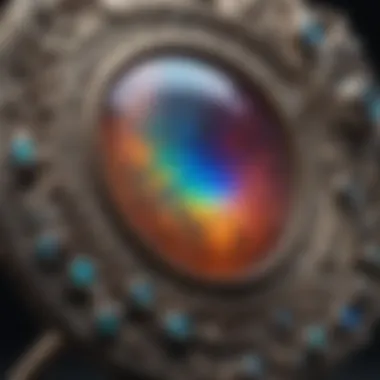
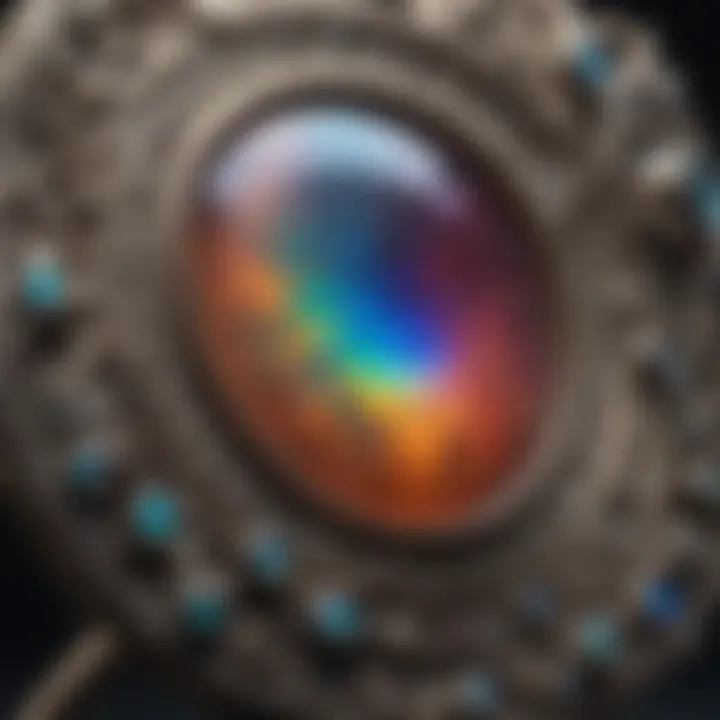
- Silica Spheres: These spheres can vary in size; smaller spheres are more likely to produce blue or violet hues, while larger spheres tend to reflect warmer colors like red and orange.
- Water Content: The water content can range between 3% to 30%. This influences both clarity and translucence, further affecting the overall color display.
The intricate patterns formed by the arrangement of silica spheres are what make each opal distinct. Thus, a thorough understanding of the structural composition enlightens one about factors that contribute to the beauty of this gemstone.
Light Interaction
Light interacts with opal in complex ways leading to its colorful display. This interaction can be examined through two main processes: diffraction and reflection.
- Diffraction: This occurs when light enters the opal and is bent or separated into different wavelengths. The size of the silica spheres dictates how certain wavelengths are affected. Hence, as mentioned, smaller spheres can create colors in the blue spectrum, while larger spheres lean towards reds and oranges.
- Reflection: Light can bounce off the surface of the opal, enhancing its luster. The cutting of the stone can affect how light enters and exits, impacting the intensity and visibility of its colors.
Understanding these processes can significantly enhance appreciation for opal as not just a stone, but as a complex interplay of light, structure, and form.
Environmental Influences
The environment in which opals form also plays a crucial role in dictating their color attributes. Factors such as temperature, underground water conditions, and the chemical elements present at the time of formation impact color development.
- Temperature Variations: Higher temperatures can lead to certain inclusions that affect light refraction, thus altering the visible color spectrum.
- Chemical Presence: The presence of minerals such as iron or nickel during formation can impart different hues, impacting the overall appearance of the opal.
- Geological Conditions: Opals often form in sedimentary rocks in specific geological settings. The conditions of these environments can lead to unique color patterns and clarity levels.
Overall, environmental influences are a significant factor in determining not only the aesthetic appeal of opals but also their market value.
Understanding these scientific principles equips buyers and collectors with the knowledge needed to evaluate and appreciate opals for their unique qualities.
Common Opal Colors
Understanding the common opal colors is essential for anyone interested in these gemstones. Each color variant embodies unique characteristics that influence not only the stone's appearance but also its value and appeal. Recognizing the diversity in opal colors allows collectors and enthusiasts to make informed decisions about their purchases or designs. The beauty and allure of opals often lie in their colors, making familiarity with these hues crucial for appreciation and valuation.
White Opal
White opal is known for its milky background and vibrant play of color. Its base color can range from translucent to opaque. The colorful flashes seen in white opal arise from the microstructure of silica spheres that diffract light. These opals are often less expensive than darker varieties, yet their beauty is striking. White opals can often show a play of color that is quite vivid, making them popular in jewelry.
Black Opal
Black opal stands out due to its dark body tone, which intensifies the brightness of its color play. The black background contrasts dramatically with the hues within the stone. This type of opal is considered the most valuable and sought after. Its striking appearance is often associated with high-quality gemstones, making it a prized possession among collectors. The origins of black opal are primarily traced to Australia, especially the Lightning Ridge region, known for its rich finds.
Boulder Opal
Boulder opal features a beautiful mix of opal and host rock, most commonly ironstone. This unique formation creates a distinctive texture and a play of color that can appear almost layered. Boulder opals tend to have less sensitivity to damage compared to other opal types due to their natural matrix. They also exhibit a myriad of colors that blend seamlessly with the ironstone, offering an earthy aesthetic that appeals to many. The unique formations are highly appreciated in the jewelry market.
Fire Opal
Fire opal is characterized by its warm body color, ranging from yellow to orange to red. The transparency can vary, and it may contain some play of color, though it is often transparent or translucent. Fire opal is generally found in Mexico and is notable for its vibrant colors. The name 'fire' comes from its fiery hues, which fascinate many collectors. Even with no play of color, fire opal can still command high prices due to its bright, warm appearance.
Crystal Opal
Crystal opal is distinguished by its clear or semitransparent appearance, showcasing a vibrant play of color within. This type may exhibit a combination of transparency with internal color displays, often resulting in beautiful effects like rainbow-like hues. Because of its unique appearance, crystal opals are highly valued in the jewelry industry. They can present a spectrum of colors, and their light-play characteristics provide endless fascination to both collectors and jewelry designers alike.
In summary, the world of common opal colors is vast and intriguing, with each variant offering something unique. From the elegance of white opals to the richness of black opals, each choice comes with its own statement and appeal.
Factors Affecting Opal Cost
Understanding the factors that affect the cost of opals is crucial for gem enthusiasts, collectors, and jewelry designers. The price of opals can vary significantly based on several characteristics, including color rarity, clarity and transparency, as well as cut and shape. Each of these elements plays a vital role in determining both the quality and desirability of opals in the market. Consequently, recognizing these factors not only aids in making informed purchasing decisions but also enhances an appreciation for this exquisite gemstone.
Color Rarity
The rarity of an opal's color can greatly influence its value. Some colors are more sought after than others due to their scarcity in nature. For instance, black opals are often considered among the rarest, featuring a rich play of color combined with a dark body tone, which enhances their appeal. In contrast, white opals, while beautiful, are generally more common and may not demand as high a price.
In addition, specific combinations of colors can elevate an opal's market value. For example, a fire opal exhibiting vibrant red and orange hues can command a premium price, especially when the color displays a striking brilliance. This interplay of color rarity and market demand forms the basis for pricing in the opal market. Therefore, buyers looking for unique pieces should carefully consider the color characteristics of the opals they wish to acquire.
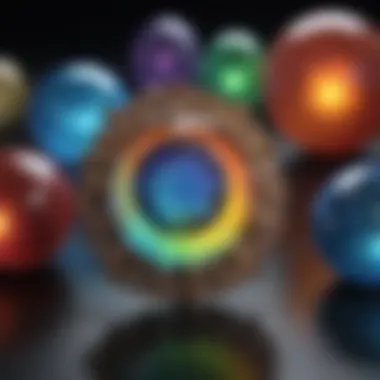

Clarity and Transparency
Clarity is another critical factor influencing opal cost. Opals can exhibit inclusions, which are internal imperfections that affect transparency. A clear opal with minimal inclusions often fetches a higher price due to its aesthetic appeal and perceived quality. Transparency allows light to interact with the stone effectively, enhancing its brilliance and play of color.
A higher quality opal typically shows minimal surface blemishes and inclusions, resulting in better light interaction and a more vivid display of colors.
When assessing clarity, it’s essential to scrutinize the opal under different lighting conditions. This practice will help in understanding how inclusions influence the overall appearance. The clearer the opal, the more valuable it is likely to be.
Cut and Shape
The cut and shape of opals also significantly affect their market value. Well-cut opals maximize the stone's color play and brilliance, showcasing the hues to their fullest potential. The precision with which an opal is cut can dramatically influence its light performance, leading to an appreciation from collectors and jewelers alike.
Different shapes, such as oval, round, or free-form cuts, cater to various tastes and design preferences in jewelry. An artistically crafted opal can draw more attention and often leads to higher prices. Moreover, the symmetry of the cut and its evenness should also be evaluated, as they contribute to the overall beauty of the piece.
In summary, an understanding of factors such as color rarity, clarity, and cut can help buyers and sellers navigate the market effectively. By keeping these aspects in mind, one can better appreciate the value of opals and make more informed decisions whether in acquisition or valuation.
Cultural Significance of Opal Colors
Understanding the cultural significance of opal colors adds depth to the appreciation of these gemstones. Opals have been revered across various cultures and epochs for their unique and striking hues, each attributed with distinct meanings and symbolism. Recognizing these cultural narratives enhances not only the aesthetic value of opals but also their emotional and historical resonance. This section explores the myriad ways in which different societies have perceived and incorporated opal colors into their traditions and beliefs.
Symbolism in Different Cultures
Each color in opals often carries its own symbolism, which can vary widely across cultures.
- White Opal: Seen as a symbol of purity and innocence in many cultures, white opals are believed to bring peace and grounding energy. In some traditions, they are associated with hope and optimism.
- Black Opal: This color is frequently related to mystery and depth. Many cultures view black opals as protective stones, thought to safeguard against negative energies.
- Fire Opal: The vibrant warm hues of fire opals often symbolize passion, energy, and vitality. In certain traditions, they are believed to inspire creativity and enhance love.
- Boulder Opal: The earthy tones are connected with the natural world, symbolizing strength and stability. Many people believe that wearing boulder opals helps to ground the wearer and connect them to their roots.
- Crystal Opal: Often associated with clarity and vision, crystal opals are thought to enhance intuition and promote emotional healing.
These cultural interpretations illustrate how opal colors transcend mere aesthetic appreciation. They embody a wider range of human experience and understanding.
Opal in Folklore
Folklore is rich with narratives that center around opals, often highlighting their magical associations. Many stories detail how opals are considered to grant powers or blessings to their wearers. For example:
- The Arab Legend: According to a legend, opals fell from the heavens during a lightning storm. This has led to the belief that opals harness the power of the elements.
- Australian Aboriginal Tales: In Aboriginal tradition, there are numerous tales connecting opals to the Rainbow Serpent, who is believed to have created the world and its waters. The various colors of opal are seen as reflections of this serpent’s beauty.
- Victorian Superstitions: In the 19th century, opals were often viewed with suspicion. Some believed they were bad luck unless owned by someone who was born with the stone’s color. These tales heightened the allure and mystery surrounding opals.
In summary, the cultural significance of opal colors is profound and multifaceted. From symbolism to folklore, opals have been woven into the fabric of societies around the world. Understanding these connections enhances one's appreciation for these stones, inviting deeper exploration of their meanings beyond the physical gemstone.
Opal Care and Maintenance
Opals require careful attention due to their unique properties. They are delicate and can be sensitive to changes in temperature and humidity. Understanding how to care for these gemstones is essential for maintain their beauty and longevity. Proper care not only preserves their vibrant colors but also protects your investment.
Taking the time to implement a maintenance routine can enhance the appeal of opals and ensure they remain in optimal condition for generations.
Cleaning Techniques
To maintain the clarity and brilliance of opals, effective cleaning is crucial. Here are some suitable cleaning techniques:
- Use Warm Water: Soak the opals in warm water mixed with a few drops of mild soap for a short duration. Do not use hot water, as it may cause cracks.
- Soft Brushes: After soaking, use a soft-bristled brush to gently scrub the surface. This helps remove dirt without scratching.
- Avoid Chemicals: Steer clear of harsh chemicals and ultrasonic cleaners, as they can damage the opal structure.
"Regular maintenance keeps your opals looking fresh and vibrant, enhancing their overall beauty."
Storage Recommendations
Storing opals properly is as important as cleaning them. Here are some key recommendations for storing your opals:
- Separate Storage: Store opals separately from other gemstones to prevent scratches. A soft pouch or a separate compartment in a jewelry box is ideal.
- Humidity Control: Keep the storage environment with moderate humidity, as opals can be sensitive to overly dry or wet conditions.
- Temperature Stability: Avoid placing opals in high-temperature areas. Extreme fluctuations can lead to damage.
By adhering to these practices, you can ensure that your opals remain stunning and integral to your jewelry collection.
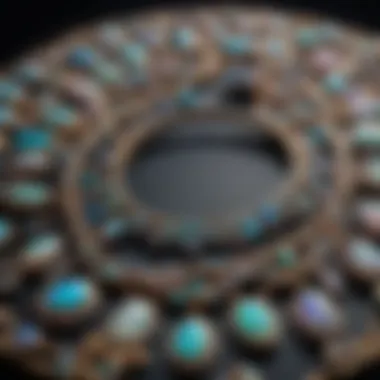
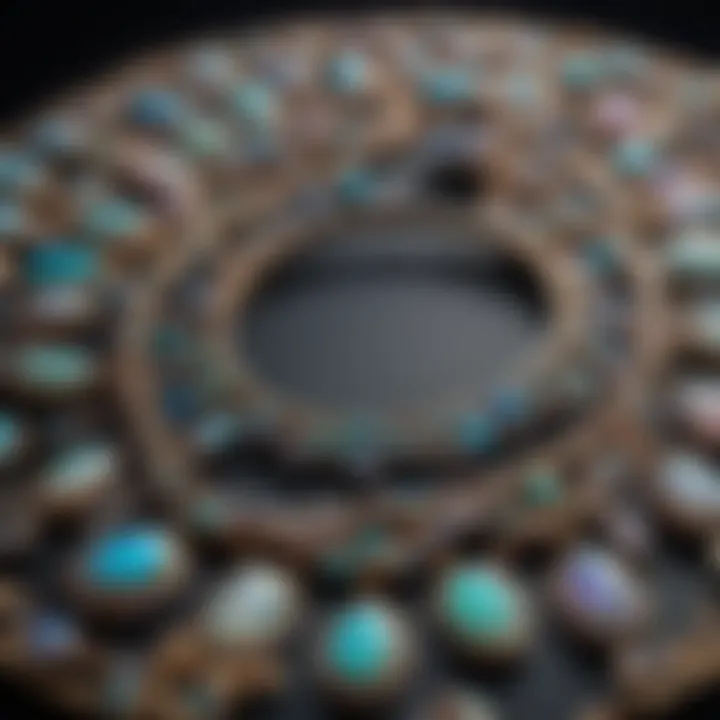
Opal in Jewelry Design
Opal is more than just a gemstone; it serves as a canvas for creativity in jewelry design. Its unique play-of-color and diverse hues provide a broad range of possibilities for artisans and collectors alike. The ability of opals to shift colors under different lighting conditions adds a dynamic element to any piece of jewelry, making it significantly appealing in the luxury market.
The presence of opals in jewelry extends far beyond mere aesthetics. Opals command a certain elegance and allure, drawing attention to their wearers. In today’s fashion, these gemstones are favored by both designers and enthusiasts who appreciate their unique properties. The organic feel of opals, along with their artistic potential, ensure they remain a relevant choice in contemporary craftsmanship.
Incorporating opals into jewelry requires careful consideration of various factors, including:
- Design Balance: Opals can be bold statements or subtle accents. The layout must enhance the opal's inherent beauty.
- Gemstone Quality: The quality of the opal is crucial. Higher quality opals exhibit more vibrant hues and stronger play-of-color.
- Metal Selection: The type of metal used can influence the perceived color and overall appearance of the opal. Common choices are gold and silver, as they can complement the fiery flashes of color in opals.
Opal jewelry not only serves aesthetic purposes but also carries symbolic meanings that resonate with different cultures. Understanding these nuances can elevate jewelry design from being merely decorative to possessing deeper significance.
Popular Styles
Jewelry styles featuring opal are varied and cater to diverse tastes. Here are some of the most popular:
- Statement Rings: Utilizing large, raw opals or intricately cut stones, statement rings command attention. They can be a centerpiece in both casual and formal attire.
- Necklaces: Opal pendants can range from single stones to elaborate designs that intersperse diamonds or other gemstones, creating a stunning visual effect.
- Earrings: Opal earrings come in various styles, from studs to dangling designs. They provide a subtle way to incorporate color without overpowering the overall look.
- Bracelets and Bangles: These can incorporate multiple opals in a single piece or feature a unique design that showcases one stunning opal.
The adaptability of opals allows them to be included in various jewelry types, ensuring that there is a suitable style for every preference.
Pairing Opals with Other Stones
The interaction between opals and other gemstones can enhance their already captivating appearance. Pairing them thoughtfully can elevate the overall piece:
- Diamonds: Utilizing diamonds with opals offers a contrasting brilliance that highlights the opal's colors beautifully. They are often used in engagement rings or statement pieces.
- Sapphires: The deep blue of sapphires complements the lighter shades of opals well, creating a sophisticated contrast.
- Emeralds: Pairing opals with emeralds produces a rich color palette. The green of emeralds often forms a beautiful backdrop that accentuates the opal's luminous hues.
- Pearls: The softness of pearls when juxtaposed with opal can create a soft yet striking look, perfect for vintage-style designs.
Understanding how to combine opals with other stones is an art. The right pair accentuates the unique qualities of each gemstone, creating harmony in design.
In summary, opals hold a vital role in jewelry design, offering endless possibilities for creativity. Their pairing with other gems is particularly advantageous, allowing for stunning visuals and personal expression in adornments.
Market Trends for Opals
In the world of gemstones, understanding market trends is essential for those who love and invest in stones like opal. The opal market is influenced by various factors, including consumer preferences, cultural significance, and availability. As opal colors are diverse, so are the trends that surround them. Analyzing these trends can provide valuable insights for both collectors and jewelry designers, as well as anyone looking to purchase opals.
Current Valuation
Currently, the valuation of opals is shaped by a combination of color characteristics and market demand. Factors such as rarity of colors, especially among black opals and boulder opals, play a significant role in determining price. For instance, vivid colors with strong fire patterns or unique play-of-color effects are often valued higher. This high demand can lead to increased prices for exquisite specimens.
Recent reports suggest that well-cut opals can fetch prices that range significantly based on their visual appeal and structural quality. Collectors often look for certification from gemological institutes to ensure authenticity and value, which can affect resale potential.
Other aspects like clarity and transparency also influence opal valuation. Clear stones with minimal inclusions are generally preferred, as they highlight the color displays better.
Future Predictions
Looking into the future, the opal market might see some shifts influenced by broader economic factors and changing consumer behaviors. Experts predict an increase in demand for ethically sourced and sustainably mined opals. Consumers are becoming more environment-conscious and prefer stones that are harvested responsibly.
Additionally, there is a potential rise in value due to scarcity. As mining activity decreases in some prominent opal-producing regions, the supply could tighten, elevating prices over time. Emerging markets in Asia and the Middle East also present new opportunities for growth, with increasing interest among jewelry consumers.
Moreover, the effects of digital marketing and online sales platforms can reshape how opals are bought and sold. As more people turn to online sources for purchasing gemstones, maintaining transparency and trust is crucial.
End
In summarizing the essence of opal colors, it is clear that their significance extends beyond mere aesthetic appeal. The exploration of opal colors reveals the intricate connection between their scientific properties and cultural perceptions. Understanding the factors that affect the colors of opals enriches appreciation. As highlighted throughout this article, geological, environmental, and structural elements intertwine to craft each stone’s unique beauty.
Moreover, the implications for value and desirability cannot be overlooked. Buyers and collectors must consider factors like color rarity, clarity, and origin. The insights into how these elements influence cost and attractiveness are particularly crucial for informed purchases. Gemstone enthusiasts, collectors, and jewelry designers should grasp these intricacies to navigate the opal market effectively.
Key Takeaways
- Opal colors are a blend of structural and environmental influences.
- Cultural significance varies, affecting the desirability of shades.
- Value is deeply connected to color rarity and other quality metrics.
Final Thoughts on Opal Color
The world of opal colors is fascinating and complex. Each hue tells a story of its formation and cultural significance. Appreciating opal demands an understanding of its scientific and historical context. Gemstone enthusiasts would do well to deepen their knowledge, as this will enhance both personal enjoyment and potential investment decisions.



